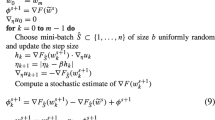Abstract
Non-convex models, like deep neural networks, have been widely used in machine learning applications. Training non-convex models is a difficult task owing to the saddle points of models. Recently, stochastic normalized gradient descent (SNGD), which updates the model parameter by a normalized gradient in each iteration, has attracted much attention. Existing results show that SNGD can achieve better performance on escaping saddle points than classical training methods like stochastic gradient descent (SGD). However, none of the existing studies has provided theoretical proof about the convergence of SNGD for non-convex problems. In this paper, we firstly prove the convergence of SNGD for non-convex problems. Particularly, we prove that SNGD can achieve the same computation complexity as SGD. In addition, based on our convergence proof of SNGD, we find that SNGD needs to adopt a small constant learning rate for convergence guarantee. This makes SNGD do not perform well on training large non-convex models in practice. Hence, we propose a new method, called stagewise SNGD (S-SNGD), to improve the performance of SNGD. Different from SNGD in which a small constant learning rate is necessary for convergence guarantee, S-SNGD can adopt a large initial learning rate and reduce the learning rate by stage. The convergence of S-SNGD can also be theoretically proved for non-convex problems. Empirical results on deep neural networks show that S-SNGD achieves better performance than SNGD in terms of both training loss and test accuracy.
Similar content being viewed by others
References
Bottou L. Online learning and stochastic approximations. On-line Learn Neural Netw, 1998, 17: 142
Robbins H, Monro S. A stochastic approximation method. Ann Math Statist, 1951, 22: 400–407
Chen C Y, Wang W L, Zhang Y Z, et al. A convergence analysis for a class of practical variance-reduction stochastic gradient MCMC. Sci China Inf Sci, 2019, 62: 012101
Tseng P. An incremental gradient(-projection) method with momentum term and adaptive stepsize rule. SIAM J Optim, 1998, 8: 506–531
Duchi J, Hazan E, Singer Y. Adaptive subgradient methods for online learning and stochastic optimization. J Mach Learn Res, 2011, 12: 2121–2159
Ghadimi S, Lan G. Accelerated gradient methods for nonconvex nonlinear and stochastic programming. Math Program, 2016, 156: 59–99
Ding F, Yang H Z, Liu F. Performance analysis of stochastic gradient algorithms under weak conditions. Sci China Ser F-Inf Sci, 2008, 51: 1269–1280
Nemirovski A, Juditsky A, Lan G, et al. Robust stochastic approximation approach to stochastic programming. SIAM J Optim, 2009, 19: 1574–1609
Krizhevsky A, Sutskever I, Hinton G E. Imagenet classification with deep convolutional neural networks. In: Proceedings of Advances in Neural Information Processing Systems, Lake Tahoe, 2012. 1097–1105
LeCun Y A, Bottou L, Orr G B, et al. Neural Networks: Tricks of the Trade. Berlin: Springer Science & Business Media, 2012. 9–48
Keskar N S, Mudigere D, Nocedal J, et al. On large-batch training for deep learning: generalization gap and sharp minima. In: Proceedings of International Conference on Learning Representations, Toulon, 2017
Sutskever I, Martens J, Dahl G E, et al. On the importance of initialization and momentum in deep learning. In: Proceedings of International Conference on Machine Learning, Atlanta, 2013. 1139–1147
Hazan E, Levy K, Shalev-Shwartz S. Beyond convexity: stochastic quasi-convex optimization. In: Proceedings of Advances in Neural Information Processing Systems, Montréal, 2015. 1594–1602
Levy K Y. The power of normalization: faster evasion of saddle points. 2016. ArXiv:1611.04831
Fang C, Li C J, Lin Z, et al. Spider: near-optimal non-convex optimization via stochastic path-integrated differential estimator. In: Proceedings of Advances in Neural Information Processing Systems, Montréal, 2018. 689–699
Zhang J, He T, Sra S, et al. Why gradient clipping accelerates training: a theoretical justification for adaptivity. In: Proceedings of International Conference on Learning Representations, Addis Ababa, 2020
Nesterov Y E. Introductory Lectures on Convex Optimization: A Basic Course. Berlin: Springer Science & Business Media, 2004
Wilson A C, Mackey L, Wibisono A. Accelerating rescaled gradient descent: fast optimization of smooth functions. In: Proceedings of Advances in Neural Information Processing Systems, Vancouver, 2019. 13533–13543
Ge R, Huang F, Jin C, et al. Escaping from saddle points-online stochastic gradient for tensor decomposition. In: Proceedings of Conference on Learning Theory, Paris, 2015. 797–842
Zinkevich M. Online convex programming and generalized infinitesimal gradient ascent. In: Proceedings of International Conference on Machine learning, Washington, 2003. 928–936
Johnson R, Zhang T. Accelerating stochastic gradient descent using predictive variance reduction. In: Proceedings of Advances in Neural Information Processing Systems, Lake Tahoe, 2013. 315–323
Lei L, Ju C, Chen J, et al. Non-convex finite-sum optimization via SCSG methods. In: Proceedings of Advances in Neural Information Processing Systems, Long Beach, 2017. 2348–2358
Allen Z, Bengio S, Wallach H, et al. Natasha2-faster non-convex optimization than SGD. In: Proceedings of Advances in Neural Information Processing Systems, Montréal, 2018. 2680–2691
Defazio A, Bottou L. On the ineffectiveness of variance reduced optimization for deep learning. In: Proceedings of Advances in Neural Information Processing Systems, Vancouver, 2019. 1753–1763
He K, Zhang X, Ren S, et al. Deep residual learning for image recognition. In: Proceedings of the IEEE Conference on Computer Vision and Pattern Recognition, Las Vegas, 2016. 770–778
Krizhevsky A, Hinton G E. Learning Multiple Layers of Features From Tiny Images. Technical Report TR-2009. 2009
Yuan Z, Yan Y, Jin R, et al. Stagewise training accelerates convergence of testing error over SGD. In: Proceedings of Advances in Neural Information Processing Systems, Vancouver, 2019. 2604–2614
Acknowledgements
This work was supported by Science and Technology Project of State Grid Corporation of China (Grant No. SGGR0000XTJS1900448).
Author information
Authors and Affiliations
Corresponding author
Rights and permissions
About this article
Cite this article
Zhao, SY., Xie, YP. & Li, WJ. On the convergence and improvement of stochastic normalized gradient descent. Sci. China Inf. Sci. 64, 132103 (2021). https://doi.org/10.1007/s11432-020-3023-7
Received:
Revised:
Accepted:
Published:
DOI: https://doi.org/10.1007/s11432-020-3023-7




